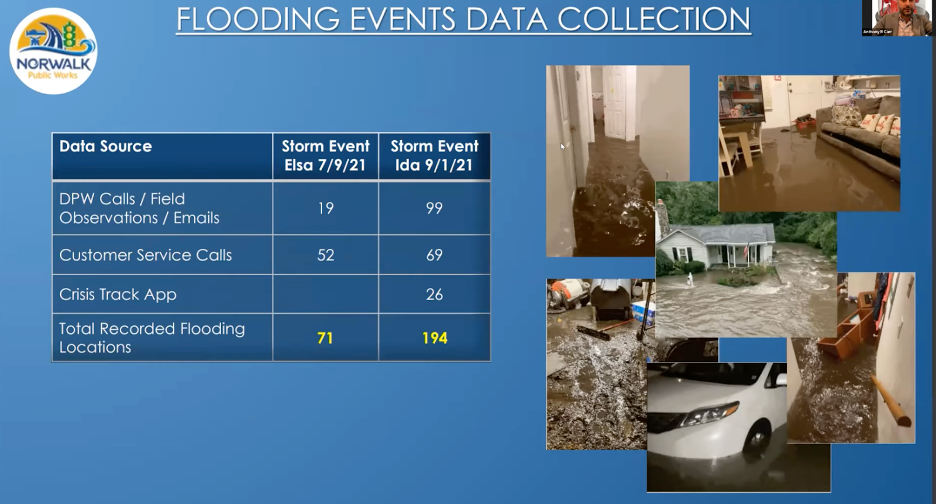Norwalk Common Council Gets Updates on Flooding Work
Six flooding mitigation projects across Norwalk could help residents and business owners dealing with water-related challenges.

When Tropical Storm Elsa hit Norwalk in July 2021, more than 70 locations across the city reported flooding issues. When the leftovers of Hurricane Ida hit Norwalk on September 1, 2021, almost 200 flooding spots were reported.
Chief of Operations Anthony Carr told the Common Council at its meeting on June 14 that “flooding is typically historical,” meaning the same problem areas flood when there’s a bad storm, but that flooding across the city “has gotten worse.”
That’s part of why Carr and consultant Woodard and Curran, an engineering and design firm, gave the Common Council an overview of their work to address flooding in the city.
Much of the city’s data on flooding comes from residents, Carr noted. Residents experiencing flooding (or other issues, such as potholes) can call the city’s customer service desk at 203-854-3200 or report their issues through the Click and Request app. The data could also be used to inform projects, such as the flood mitigation projects the city has underway.
There are six currently in the works across the city, with some currently under construction and others still in the design phase. Carr noted that these weren’t the only ones taking place, but these were “the most significant.”
Betts Brook/Dreamy Hollow Improvements
“This project was on the books for at least 30 years,” Carr said. “There were a lot of residents who had rightful concerns about flooding and sanitary sewer issues in that area.”
The $7.1 million project, which is currently under construction, includes upgrades to the capacity of the drainage system, replacing some drainage issues, and improving the aged sanitary sewer and water infrastructure. There’s also an additional $1 million being spent in this area by the city’s Water Pollution Control Authority to address sanitary sewer challenges.
“This is the biggest drainage project we’ve done in a long time,” Carr said.
He noted that almost 50 buildings would see a reduction in flooding issues related to this project.
Lockwood Lane and Heather Lane Drainage Improvements
This area of the city has had “historic issues that were exacerbated by Tropical Storms Elsa and Ida,” Carr said. He added the residents in this area were “inundated” during those storms.
The design work for the improvements to this area, which include “holistic storm sewer improvements” is projected to be done this fall, Carr said.
Bouton Street Drainage Improvements
Work is being done on a flood mitigation study in this area, Carr said. This area is a little complicated due to the railroad track, he said. However, residents here experienced significant flooding during those summer storms, “several feet,” according to Carr, so the city wants to evaluate the area and see what can be done.
The next steps include getting funding for design and construction work.
Glendenning Street Watershed Drainage Improvements
A study of the area, which includes evaluating the drainage system and listing potential mitigation ideas, is currently underway.
Carr said that this is “an area prone to flooding.”
Glenwood and Clinton Avenue Watershed Drainage Improvements
An evaluation of the area’s drainage system is currently underway. Carr noted that this area was also significantly impacted by Elsa and Ida. The study will also include the “same menu of flood mitigation options that balances public needs and cost,” Carr said.
“The purpose of these studies is to tell us what the improvements should be,” he said.
New Canaan/Ponus Avenue Drainage Improvements
Sizewise, this is the largest area project the city is working on, as more than 600 acres are included in the New Canaan/Ponus Avenue study area.
“It’s a very steep watershed—one of the challenges is water moves quickly through it,” said Joe Kirby, an engineer with Woodard and Curran working on this project. Because of that, it’s hard to “trap” the water in one spot since it rushes through the area quickly.
Kirby outlined three main ways to provide improvements in this area:
- Installing a new trunkline, or main drain line, for $11.7 million, which would remove 47 buildings from flood areas and reduce flooding in an additional 57 buildings.
- Installing a pump station for $20 million, which would remove 10 buildings from flood areas and reduce flooding in an additional 78 buildings.
- Creating a water shortage space for $2.7 million, which would remove 6 buildings from flood areas and reduce flooding in an additional 77.
Kirby also noted that the first option could be broken into two—doing a downstream trunkline and then an upstream trunkline separately.
These options will now be reviewed by city staff and city officials to see which one makes sense to request funding for.
“What’s really important is that it shows a fair and equitable geographic spread of the flood mitigation projects going on in the city,” Carr said.
As the studies are being done and the work is being completed, the public works department is also continuing to go out to about 20 hotspots across the city to make sure drains and pipes are clear and that there’s no standing water before a big storm to try and limit the impacts. Still, Carr noted that the best way to mitigate flooding is to work on these long-term solutions.
“The purpose of these studies is to tell us what the improvements should be,” he said.
